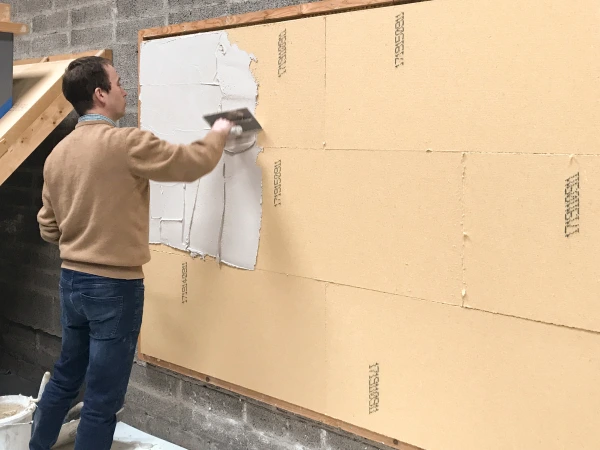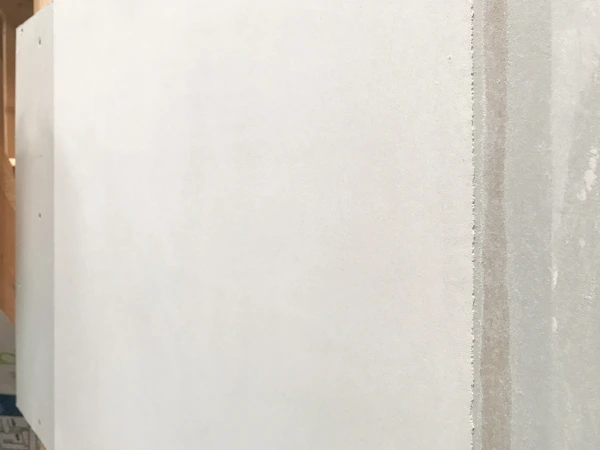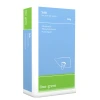Lime Green Solo
Product Overview
Main purpose
A finishing plaster that provides a smooth topcoat and maintains the breathability of the wall.
Lime Green Solo is a component of the Retro EcoWall solution.
Use it on
Suitable for a wide range of backgrounds including masonry and existing plaster, Gutex Thermoroom wood fibre insulation boards, any Diasen Diathonite plaster or other lime-based plaster.
Overview
Lime Green Solo is an internal lime plaster suitable for a wide range of surfaces including wood-based panels, masonry and wood fibre insulation boards. It saves time during installation and helps promote a healthy indoor climate. It is highly breathable (vapour permeable) and can be finished to a smooth surface in just one coat.
Features
- Just add water
- Easy installation
- Lime based – breathable
- Contains only natural materials
- High mould resistance
- Adaptable for a range of substrates
- CE Marked
Benefits
- Easy to achieve consistent mix with excellent workability.
- Can be hand applied in one coat.
- Experienced lime plasterers can install it without special training.
- Suitable for historic/listed Buildings, it regulates humidity and prevents mould growth.
- Can be used in projects with environmental requirements. Does not contain cement.
- UK manufactured product, which can be specified in any UK or Ireland project.
Questions
What paint should I use over the Lime Green Solo?
Technical Details
Key Technical Data
Installation Guide
How to Install
Preparation
When unsure, always carry out a test for compatibility with the surface before beginning application.
The temperature must be between 5°C and 30°C during mixing, application and drying. If the temperature drops below 5°C during mixing or application, use heaters to warm the room before continuing.
Dampen dry and porous backgrounds before application. It is important not to allow Lime Green Solo to dry out too fast when applied over a highly absorbent surface.
Lime Green Solo is not suitable for excessively wet or continuously damp surfaces. It should be applied to uniformly level walls. Uneven walls should be first levelled with Diathonite insulated plaster or other lime-based plaster.
Do not prime the walls with PVA.
How to Mix
Add 5-7 litres of clean water to each 25kg bag of plaster and mix for 3 to 5 minutes.


How to Apply
Finishing plaster on top of Diathonite insulation plaster:
Mist the surface with water if very dry. Apply Lime Green Solo in one pass, levelling with a straight edge or stainless-steel plaster spatula as you go. It does not need to be entirely flat or smooth at this point. Once the plaster begins to set and is firm enough so that touching it with your finger does not cause an indentation (approximately 2 hours), use a damp sponge to smooth out any high/low points or trowel marks. If a smoother finish is required, leave for about 30 minutes then polish the surface with a steel or flexible plastic trowel to produce an excellent smooth finish. Do not over-work the surface as this may lead to fine cracking.
On Woodfibre Insulation Boards:
Apply 5mm of Lime Green Solo then cover with Thermoroom reinforcing mesh. Use a trowel to gently embed the mesh into the surface of the plaster. Immediately apply a second 5mm coat of Solo on top. Use a wide plaster spatula to preliminary smooth the surface; it doesn’t need to be perfect at this stage. Once the plaster begins to set and is firm enough so that touching it with your finger does not cause an indentation (approximately 2 hours), use a damp sponge to gently smooth out the surface and level out any trowel marks or uneven areas. The sponge provides a level final finish with a semi-smooth texture. If you would prefer a smoother finish, use a flexible trowel 30 minutes after sponging to polish the surface. The Lime Green Solo should then be painted with a natural breathable paint such as Auro.
Do not over work the surface as this may lead to fine cracking.
Hints & Tips
Allow at least 2 weeks drying time, during which time the plaster should be protected from rapid or forced artificial drying (applying additional heat). If the environment is very warm or the plaster is drying very quickly, mist the surface with water. If the temperature drops below 5°C, use supplementary heating to raise the temperature, in the room.




